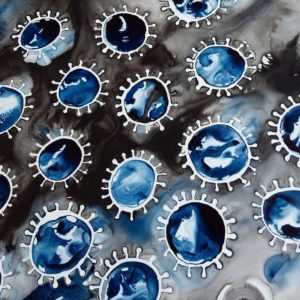
Daniel Griffin provides a clinical update on COVID-19, then we review an Ad5 vectored SARS-CoV-2 vaccine, reports on remdesivir and hydroxychloroquine, a drug repurposing study, why some patients infect many others, reducing viral transmission, and much more, including listener email.
Hosts: Vincent Racaniello,Dickson Despommier, Alan Dove, Rich Condit, Kathy Spindler and Brianne Barker
Guests: Daniel Griffin and Chuck Knirsch
Click arrow to play
Download TWiV 621 (91 MB .mp3, 152 min)
Subscribe (free): iTunes, Google Podcasts, RSS, email
Become a patron of TWiV!
Links for this episode
- Safety of Ad5 vectored COVID-19 vaccine (Lancet) 43:04
- Analysis of hydroxychloroquine use (Lancet) 50:14
- Remdesivir study (NEJM) 52:55
- Ancient COVID-19 history (MMWR) 55:06
- Drug repurposing for COVID-19 (bioRxiv) 57:00
- Why do few COVID-19 patients infect others? (Science) 1:00:57
- Overdispersion in COVID-19 transmission (Wellcome Open Res) 1:05:13
- Reducing airborne transmission (Science) 1:06:21
- Image credit
- Letters read on TWiV 621 31:54, 37:38, 41:09. 1:10:28
- Kiki’s Comments
- Timestamps by Jolene. Thanks!
Intro music is by Ronald Jenkees
Send your virology questions and comments to [email protected]


Another great podcast. Thanks!
Was wondering if you have looked at the following Edridge et al. May 2020 Dutch preprint study on antibodies for 4 common cold Coronaviruses, sampled for 35 years, this paper on 10 men (3 to 6 month interval testing). They also tested antibody reactions for SARS-CoV-2, samples prior to current pandemic.
“Human coronavirus reinfection dynamics: lessons for SARS-CoV-2”
https://www.medrxiv.org/content/10.1101/2020.05.11.20086439v1
G’Day
I’d be interested in knowing more about the significance of adenovirus and vaccines. I don’t understand the background references, and seeming inside joke about chimp or Ad5 platform, made by Prof Spindler and others.
Please direct to TWiV podcasts where I can backfill this information.
Many thanks and stay healthy!
Johnye
I love listening to all of you. My education never stops! Is there any data on what the particle-to-PFU ratio is for SARS-CoV-2? How might that ratio affect (or not affect) prevention measures? Also, since I am naïve enough to assume that a virus-is-a-virus-is-a-virus, and if these viruses have characteristics that make them all SARS-CoV-2, why would only a certain proportion of them lead to successful infection of cells and not all of them? In other words, what actually determines a particle-to-PFU ratio? You guys are terrific. Keep on truckin’ !
Two questions: Can someone comment on the sudden increase (“reverse,” increasing knee in the curve) for the exponential growth rate of covid-19 cases in AZ? (Three days ago AZ surpassed WA in total cases, https://pattimichelle.com/model_prediction.html#cases – occurring about 3 weeks after AZ “Opened Up.” Although this phenomenon is only a week or so old, the cases growth rate also appears to be faster than exponential. Note that AZ and WA have similar populations.) This is the first obvious case of a reverse knee in a cases’ curve among JHU states’ data tracked/analyzed for the last 4 months for CA, WA, FL, CO, PA, NY, and TX. Is such a ‘cases’ growth-rate increase expected to precipitate an increase in the AZ deaths curve a few weeks from now?
Secondly, from a global Systems Dynamics point of view, pandemics are an increasing part of the Anthropocene (e.g., Meadows and Meadows [1972], Meadows, et al., [2018], etc.). As Prof. Racaniello points out in his class, most extremely serious human diseases (I recall pertussis and smallpox off the top of my head) were also zoonoses, as sars2. What are thoughts on the next novel zoonotic pandemic; will it be relatively gentle; as sars2, or much more virulent; as smallpox? I suspect the former, as bats may be considered a primary future source of zoonoses (TWiV mentioned ~1 in 5 mammals on earth is a bat).
How does one send a letter, to be discussed on the show? If this is how, I’ll post my question below. If this is not how, let me know.
I live in the US. My wife works in a school (k-4th grade). The school staff are trying to decide how to reopen for the next school year.
We know someone who lives in Sweden. Sweden did not close schools for certain age ranges. Their kids (9 and 13, I believe), for instance, are going and have been going to school. Schools for older children (not sure of the cutoff) and colleges were closed.
As far as I can tell, there is no difference in what the schools are doing in Sweden. In other words, there is no rotating schedule, social distancing, etc.
Is this a viable model for the US? If not, why not? And can you explain why Sweden’s schools have not been (ostensible) vectors of transmission for covid-19?
Could you please not flaunt your Socio-Economic Status on the show? (expensive hobbies, living arrangements, trips, etc.) You may be aiming for “playful and relaxed” atmosphere, but it really gets in the way of credibility for serious caring in this exceedingly serious time.